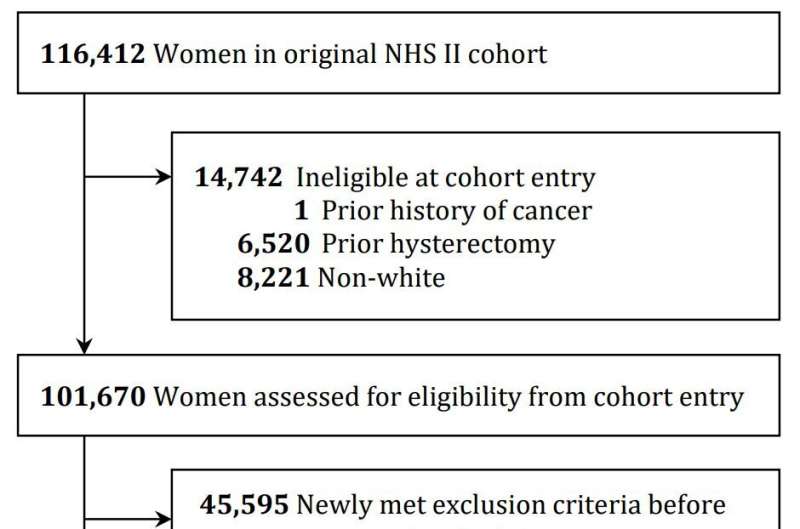This article has been reviewed according to Science X's editorial process and policies. Editors have highlighted the following attributes while ensuring the content's credibility:
fact-checked
trusted source
proofread
New model identifies women at high risk for endometrial cancer

Endometrial cancer is the most common gynecological malignancy in the United States yet current guidelines do not recommend screening for endometrial cancer for individuals already at high endometrial cancer risk, such as those with Lynch syndrome. However, a new study by investigators from Brigham and Women's Hospital, Harvard Medical School, and the Harvard T.H. Chan School of Public Health developed a predictive model that can be translated into research and eventually clinical settings to identify high-risk individuals who would benefit from such screening.
"Given the rising incidence and mortality rate of endometrial cancer, population screening to identify high risk women is an attractive public health strategy," said first author Joy Shi, Ph.D., of the Department of Epidemiology at Harvard T.H. Chan School of Public Health.
"I was interested in leveraging the incredibly rich questionnaire and genetic data available from the Epidemiology of Endometrial Cancer Consortium (E2C2) and combining it with other nationally representative data sources to assess whether we could improve on our ability to predict endometrial cancer risk in the general population."
Their results are published in the JNCI: Journal of the National Cancer Institute. The model was trained on pooled data from an international consortium spanning 19 studies across different countries before being validated in three large U.S.-based cohorts.
The only two previous risk models for endometrial cancer were trained on much more selective study populations and did not include risk factors like education, history of diabetes, history of hypertension, or use of hormonal therapy. To the author's knowledge, this is also the first to assess the utility of genetic factors in endometrial cancer risk prediction.
Shi and colleagues began by using data from 19 case-control studies involving postmenopausal white women between ages 45-85 in the E2C2 to develop their model.
They used a statistical tool called a LASSO model to predict which individuals would be at a higher risk of endometrial cancer relative to others in the cohort. Then, they translated these relative risks into an absolute risk prediction to determine the probability that an individual, given their characteristics, develops endometrial cancer in the next 10 years.
This analysis required them to combine estimates from the E2C2 data with nationally representative data from the Surveillance, Epidemiology, and End Results (SEER) Program and the National Health and Nutrition Examination Survey (NHANES).
Then, the model was validated using data from 121,700 female registered nurses aged 30-55 years in the Nurses' Health Study (NHS), 116,430 female registered nurses aged 25-42 years from the Nurses' Health Study II (NHS II), and 78,232 women aged 55-74 years from PLCO. Participants were followed for 10 years in all three validation cohorts. Questionnaires, death records, and medical records were used to confirm diagnosis of endometrial cancer by pathologists and physicians.
"NHS, NHSII and PLCO are cohorts with uniquely rich datasets, with data on tens of thousands of participants over decades of follow-up," said senior author Immaculata De Vivo, Ph.D., MPH, and Professor of Medicine at Brigham and Women's Hospital and Harvard Medical School. "There is also genetic data available for many of these study participants, which allowed us to investigate the potential contributions of genetic factors in predicting endometrial cancer risk."
Specifically, the team matched 18 previously identified genome-wide significant single nucleotide polymorphisms (SNPs) for endometrial cancer from 12 different genome-wide association studies (GWAS) of various disease outcomes with the NHS population.
Researchers found that, on average, cumulative risk of endometrial cancer for women between ages 45-85 was 5.4 percent, though the range went from a risk of 1.4-1.8 percent for women in the lowest decile of risk to 13.7 to 15.01 percent for women in the highest decile.
Researchers found that the epidemiologic model demonstrated moderate accuracy with only slight improvements when genetic factors were included. The epidemiologic model was well-calibrated in the NHS II data, but poorly calibrated in the NHS data. However, both the epidemiologic and the epidemiologic plus genetic models were well calibrated in PLCO.
"We found that epidemiologic risk factors alone, which could be quickly, cheaply and easily collected in clinical or public health settings, could accurately distinguish between women at high and low risk for endometrial cancer," Shi said.
When the risk model was applied to a more recent and representative U.S. population of white women, the model identified 2.5 percent of women with more than 20 percent cumulative risk of endometrial cancer between ages 40-85. Those in the 97th percentile of risk had a predicted lifetime risk comparable to that in Lynch patients, who are recommended annual screening.
These findings suggest that clinical guidance about endometrial cancer screening could be updated. However, since 95 percent of the training cohort and 93-95 percent of the validation cohorts consisted of White women, the model does not generate and validate race-specific estimates for non-White women. The E2C2 consortium has been awarded a grant to understand disparities in endometrial cancer mortality across racial subgroups.
Models will need to continually be recalibrated in new geographic, temporal, or population settings to account for rarer subtypes of endometrial cancer and make predictions in more diverse populations.
More information: Joy Shi et al, Risk prediction models for endometrial cancer: development and validation in an international consortium, JNCI: Journal of the National Cancer Institute (2023). DOI: 10.1093/jnci/djad014


















